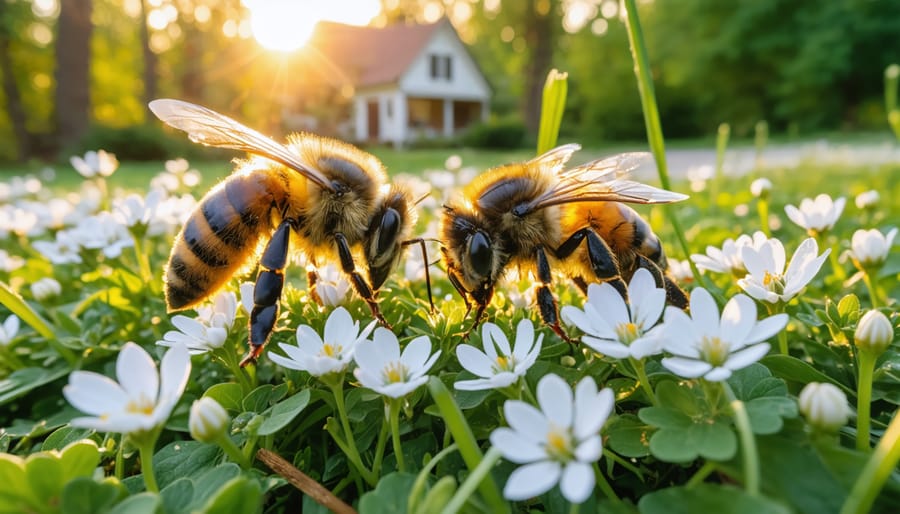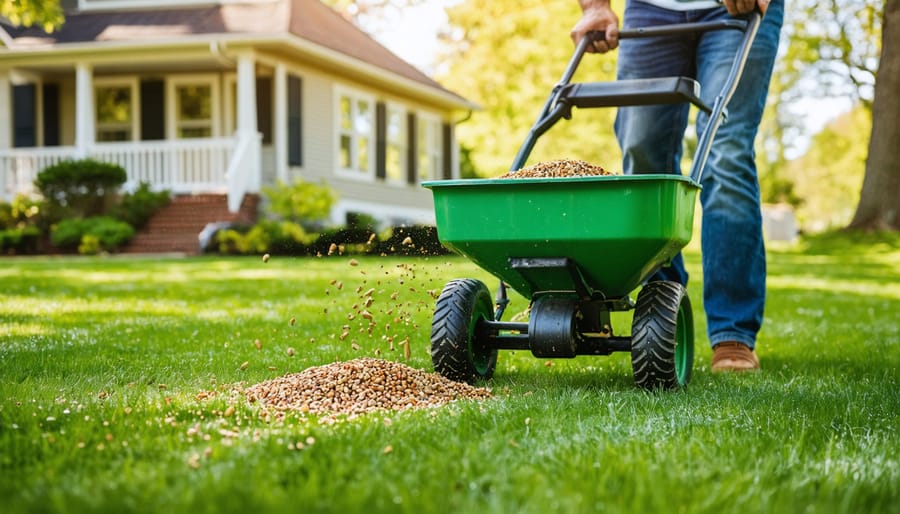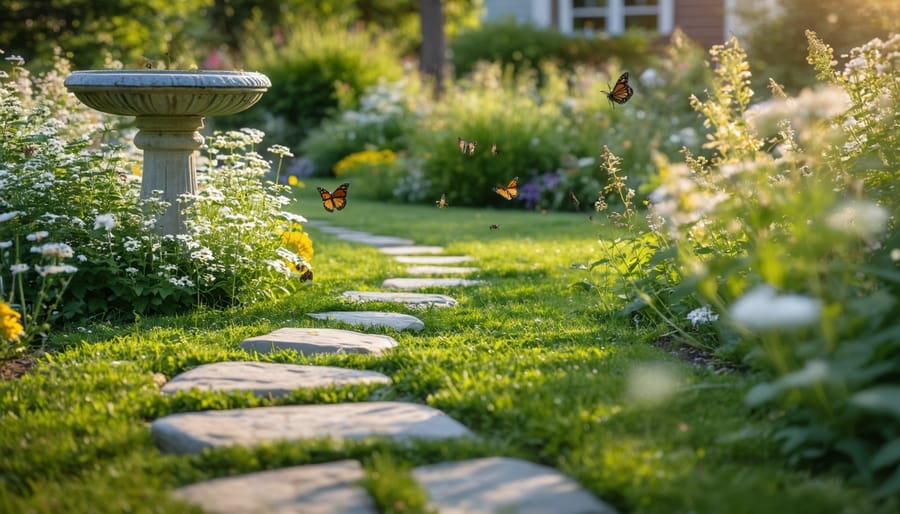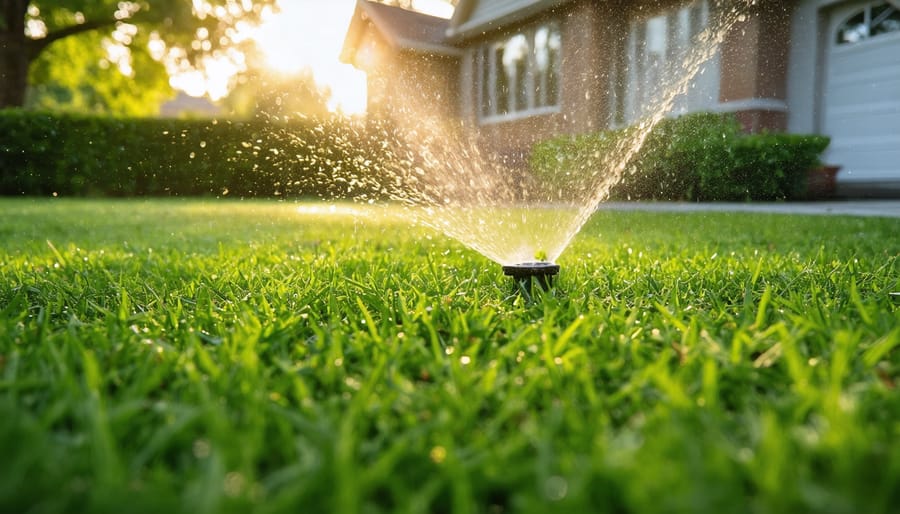Replace chemical fertilizers with compost tea applications every 4-6 weeks during the growing season—simply steep finished compost in water for 24 hours and spray across your lawn to deliver nutrients while feeding beneficial soil microbes that pollinators depend on. Set your mower blade to 3-4 inches high and leave grass clippings where they fall; taller grass shades out weeds naturally, retains moisture better, and those clippings return nitrogen to your soil without any synthetic inputs.
Your lawn doesn’t need to be a green desert. Every weekend, over 50 million Americans fire up gas-powered mowers that emit as much pollution in one hour as driving a new car 300 miles, while simultaneously dousing their yards with chemicals that kill the very pollinators our ecosystem desperately needs. The irony? We’re working harder and spending more to create landscapes that harm both our environment and our wallets.
The good news is that eco-friendly lawn care isn’t about sacrificing the lush, healthy lawn you want—it’s about working smarter with nature instead of against it. When you adopt pollinator-friendly practices, you’re not just reducing your environmental footprint; you’re creating a thriving ecosystem right outside your door where bees, butterflies, and beneficial insects can flourish alongside your grass.
This shift requires rethinking what a “perfect” lawn looks like and embracing approaches that might seem counterintuitive at first. But thousands of homeowners have discovered that sustainable lawn care actually reduces maintenance time, cuts costs, and produces healthier, more resilient turf. You’ll spend less time fighting weeds and more time enjoying your outdoor space, all while knowing you’re contributing to the solution rather than the problem.
Let’s transform your lawn into a pollinator haven without compromising on beauty or function.
Why Traditional Lawn Care Practices Devastate Pollinator Populations
The Pesticide Problem You Can’t See
The lawn care products lining store shelves often contain hidden dangers that extend far beyond what you can see on your grass. These chemicals work beneath the surface, creating lasting problems for the pollinators we all depend on.
Neonicotinoids, commonly known as “neonics,” are particularly troublesome systemic insecticides. Unlike older pesticides that wash away, these chemicals are absorbed into every part of the plant—roots, stems, leaves, pollen, and nectar. When bees collect pollen from treated grass or nearby flowers, they’re ingesting toxins that attack their nervous systems. Even at low doses that don’t immediately kill them, neonics interfere with navigation abilities, making it difficult for bees to find their way back to the hive. They also impair learning, making it harder for pollinators to locate food sources and remember where they found them.
The persistence factor makes this even more concerning. These chemicals can remain active in soil for months or even years, continuing to move into plants long after application. This means a single treatment doesn’t just affect pollinators for a few days—it creates a toxic environment that impacts multiple generations.
Other common lawn insecticides like pyrethroids are equally harmful, disrupting reproduction rates and colony health. The reality is that what we spray today affects the butterflies, bees, and beneficial insects our gardens desperately need tomorrow. Understanding this invisible threat is the first step toward making better choices for your lawn and the ecosystem it supports.
When ‘Weed-Free’ Means Pollinator-Free
Here’s the thing most of us don’t realize: those “weeds” we’re so determined to eliminate are actually providing a lifeline for pollinators. When you see dandelions and clover popping up in early spring, you’re witnessing nature’s perfectly timed buffet for bees, butterflies, and other beneficial insects emerging from winter.
Dandelions are among the first flowers to bloom each spring, offering crucial nectar and pollen when little else is available. White clover, often vilified in lawn care circles, is a nitrogen-fixing powerhouse that actually improves soil health while feeding pollinators throughout the growing season. Violets, creeping thyme, and self-heal are other “weeds” that double as important food sources.
The ecological cost of eliminating these plants with chemical herbicides extends beyond just removing food sources. These chemicals persist in soil and water, harming beneficial insects directly and disrupting the entire ecosystem your lawn is part of. When we spray for a picture-perfect, monoculture lawn, we’re essentially creating a green desert—beautiful to some, but devoid of life.
The good news? You can have an attractive lawn while keeping these pollinator-supporting plants. Consider them features, not flaws.
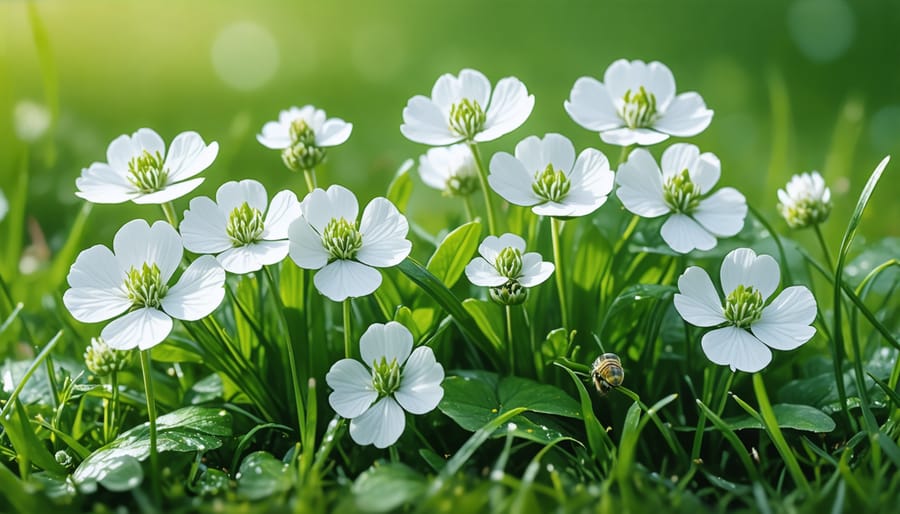
Rethinking Your Mowing Strategy for Pollinator Health
The ‘Mow High and Less Often’ Approach
One of the simplest yet most impactful changes you can make for pollinators is adjusting how and when you mow. By raising your mower blade height to 3-4 inches and cutting less frequently—perhaps every two weeks instead of weekly—you’ll create a mini-meadow effect that benefits both your lawn and local wildlife.
Here’s why this works: taller grass develops deeper root systems, making your lawn naturally more drought-resistant and reducing the need for supplemental watering. It also shades out many weeds, minimizing the temptation to reach for herbicides. But the real magic happens when you give flowering plants like clover and dandelions a chance to bloom between mowings. These “weeds” are actually pollinator powerhouses, offering crucial nectar and pollen sources when bees and butterflies need them most.
Longer grass also provides essential ground-nesting habitat for native bees—nearly 70% of bee species nest in the ground! By maintaining a slightly wilder lawn, you’re literally providing homes for these beneficial insects.
If you’re worried about neighborhood opinions, start with your backyard or create intentional “long zones” bordered by neatly mowed edges. You might be surprised how quickly neighbors appreciate the buzz of activity (pun intended!) and the reduced maintenance time. Many gardeners find that once they embrace this approach, they wonder why they ever spent so much time pushing a mower in the first place.
Creating No-Mow Zones and Pollinator Pathways
Transforming portions of your lawn into no-mow zones is one of the most rewarding steps you can take for pollinators—and honestly, it’s easier than maintaining a pristine grass monoculture! The key is identifying areas where a traditional lawn doesn’t serve much purpose anyway.
Start by surveying your yard for spots that naturally lend themselves to less maintenance. Areas along property borders or fence lines make perfect pollinator pathways, creating wildlife corridors that connect your yard to neighboring habitats. Those shady patches under trees where grass struggles to grow? They’re ideal candidates for native wildflowers and low-growing ground covers that actually thrive in shade.
Side yards, back corners, and strips beside driveways or pathways are often purely decorative—why not let them become functional wildlife havens instead? These transitional spaces can bloom with native plants that require minimal care once established.
When designating your no-mow zones, consider the flow of your outdoor space. Keep high-traffic areas like play zones and entertaining spaces as traditional lawn if needed, but allow at least 10-20% of your total lawn area to go wild. You can ease into this gradually—start with one border section this season and expand next year.
Mark your chosen areas clearly during the transition period so family members know these aren’t neglected spots but intentional pollinator sanctuaries. Within a single growing season, you’ll notice increased butterfly and bee activity, and you’ll appreciate the time saved from constant mowing and watering.
Choosing the Right Lawn Equipment for Eco-Friendly Maintenance
Electric and Battery-Powered Mowers: Better for Pollinators
Switching from gas-powered to electric or battery-powered mowers might seem like a small change, but it’s actually a significant win for your pollinator friends. Gas mowers emit a cocktail of air pollutants—including carbon monoxide, nitrogen oxides, and volatile organic compounds—that interfere with pollinators’ ability to navigate and locate flowers. Research shows these emissions can mask floral scents that bees and butterflies rely on to find food sources, essentially disrupting their GPS systems.
Beyond navigation issues, gas mower exhaust directly impacts pollinator health, weakening their immune systems and reducing their foraging efficiency. By choosing electric alternatives, you’re creating a cleaner environment where pollinators can thrive.
Today’s electric mowers deliver impressive performance without the environmental guilt. Battery-powered models from brands like EGO Power+ and Greenworks offer cutting power comparable to gas models, with runtimes sufficient for most suburban lawns. For smaller yards, corded electric mowers from manufacturers like Black+Decker provide unlimited runtime at budget-friendly prices.
When selecting an electric mower, consider your lawn size and terrain. Battery models offer greater mobility, while corded versions eliminate concerns about charge time. Either way, you’ll enjoy quieter operation, zero emissions, and the satisfaction of knowing your lawn maintenance supports rather than harms the pollinators working hard in your garden.
Manual Reel Mowers for Small Pollinator-Friendly Lawns
Let me tell you about one of my favorite discoveries in sustainable lawn care: the humble push reel mower. These human-powered workhorses are making a comeback, and for good reason—they’re absolutely perfect for pollinator-friendly lawns.
The beauty of manual reel mowers lies in their simplicity. With zero emissions and no engine noise to disturb your garden’s buzzing residents, you can mow early morning when bees are just beginning their rounds without causing disruption. I’ve noticed butterflies and other pollinators settling back onto flowers within minutes of finishing, something that never happened with my old gas mower.
For best results, keep your reel mower’s blades sharp—dull blades tear grass rather than cut it cleanly, stressing your lawn. Mow frequently, removing only about one-third of the grass height each time. This “little and often” approach works beautifully because reel mowers handle shorter grass more effectively than overgrown patches.
These mowers shine in yards under half an acre, particularly in designated zones where you’re maintaining shorter turf alongside taller pollinator meadows. The quiet operation means you can mow without disrupting your contemplative garden time or annoying neighbors. Plus, the light weight makes them surprisingly easy to maneuver around those pollinator garden beds you’ve carefully cultivated.
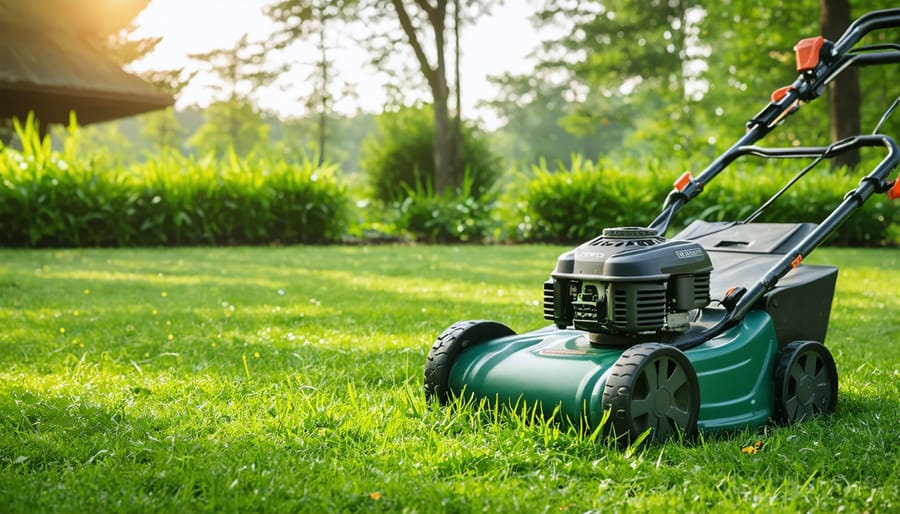
Building a Pollinator-Friendly Lawn Ecosystem
Integrating Flowering Ground Covers and Low-Growing Blooms
Transforming your lawn into a pollinator paradise doesn’t mean sacrificing that lush green look—it just means getting creative with your plant palette. Let me share some of my favorite flowering ground covers that’ll have bees and butterflies thanking you all season long.
**White clover** is the gateway plant for eco-friendly lawns, and honestly, it’s a game-changer. It fixes nitrogen naturally, staying green during droughts when traditional grass turns brown. Dutch white clover works beautifully in most climates, creating a soft carpet dotted with white blooms that pollinators adore.
**Creeping thyme** is another winner, especially for sunny areas with lighter foot traffic. Varieties like ‘Elfin’ or ‘Pink Chintz’ release a wonderful fragrance when stepped on and produce tiny flowers that bees can’t resist. Fair warning: it’s slower to establish than clover, but worth the patience.
Don’t overlook **native violets**—these sweet little plants naturalize beautifully in partially shaded lawns and provide early spring nectar when pollinators need it most. They’re also larval host plants for fritillary butterflies.
For establishment success, overseed in early fall or spring when soil temperatures are moderate. Prepare by mowing existing grass short and lightly scratching the soil surface. Mix tiny seeds with sand for even distribution, then keep consistently moist for 2-3 weeks. Start with 5-10% coverage and gradually increase—you’re creating a living tapestry, not replacing everything overnight.

Natural Lawn Fertilization That Supports Beneficial Insects
Feeding your lawn doesn’t have to mean harming the very creatures that make your garden thrive. The good news? Organic fertilizer options like composted manure, bone meal, and blood meal provide slow-release nutrients that strengthen grass without the toxic runoff that threatens pollinators.
Before you apply anything, though, get a soil test done. I can’t stress this enough—it’s like getting your lawn’s health report card. You’ll discover exactly what your soil needs instead of guessing and potentially over-fertilizing, which can actually stress your grass and contaminate water sources.
Once you know what you’re working with, compost tea applications work wonders. This liquid gold delivers beneficial microorganisms that help grass absorb nutrients naturally. I brew mine monthly during the growing season, and the difference in lawn resilience is remarkable.
Don’t overlook natural soil amendments like earthworm castings or kelp meal either. These gradually improve soil structure while feeding beneficial insects and microorganisms. Your lawn becomes a living ecosystem rather than a chemically-dependent monoculture. The butterflies and bees visiting my yard are proof that healthy lawns and thriving pollinators absolutely go hand-in-hand.
Chemical-Free Pest and Weed Management
Breaking free from synthetic chemicals doesn’t mean surrendering your lawn to weeds and pests—it just requires a shift in strategy. Hand-pulling weeds remains surprisingly effective, especially after rain when soil is loose. For a pre-emergent approach, corn gluten meal prevents weed seeds from germinating when applied in early spring and fall, though it won’t affect existing weeds.
Instead of reaching for insecticides, invite nature’s pest control team. Ladybugs, ground beetles, and lacewings feast on aphids and grubs that damage grass. Plant native flowers around your lawn’s edges to attract these beneficial insects. You can even purchase them from garden suppliers to establish populations.
Here’s the mindset shift: a perfectly uniform, weed-free lawn isn’t the goal anymore. A few clover patches or dandelions actually benefit pollinators while causing no real harm to your turf. This acceptance of natural diversity makes maintenance easier and creates a healthier ecosystem right in your yard.
Providing Essential Pollinator Resources Beyond Flowers
Water Features and Shallow Drinking Stations
Pollinators need water just as much as they need nectar, but traditional birdbaths can be drowning hazards for small insects. The solution? Create safe, shallow drinking stations throughout your lawn area.
Start with a simple shallow dish or saucer filled with clean water. Add pebbles, marbles, or flat stones to create “landing pads” that break the water’s surface. Bees and butterflies will perch on these stones while drinking, staying safe and dry. Position these stations near your pollinator plants for easy access.
If you’re incorporating water features into your landscape, consider adding a shallow basin or recirculating fountain with rocks. These serve double duty as visual focal points and pollinator watering holes.
Maintenance is minimal but important. Refresh the water every few days to prevent mosquito breeding, and clean the stones weekly to remove algae buildup. During hot summer months, check water levels daily—your tiny visitors will thank you!
Even a small terra cotta plant saucer can become a lifesaving oasis. Place several around your yard, especially in sunny spots where pollinators are most active. This simple addition completes your eco-friendly lawn’s transformation into a true pollinator haven.
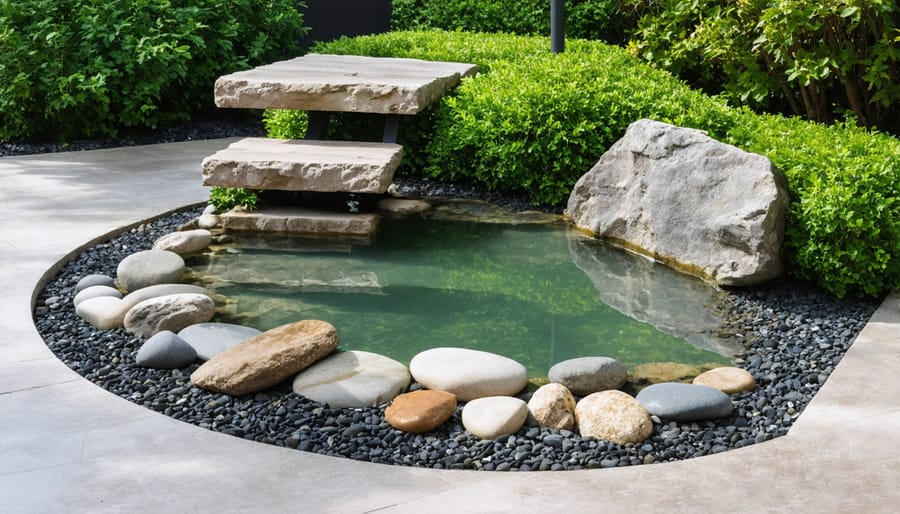
Leaving Leaf Litter and Stems for Overwintering Pollinators
Here’s something that might surprise you: that pile of leaves you’re about to bag up could be saving the lives of countless pollinators. Native bees, butterflies, moths, and beneficial beetles depend on leaving natural materials like leaf litter and plant stems to survive winter.
Many native bee species tunnel into hollow stems or nest just beneath leaf layers, while butterfly chrysalises often hide in dried foliage. When we clear everything away for a pristine look, we’re essentially evicting these helpful garden allies.
The good news? You can strike a balance between tidy and pollinator-friendly. Consider designating a corner of your yard as a “wild zone” where leaves and stems stay put until spring. If that feels too messy, gather leaves and brush into intentional piles in less visible areas—think behind shrubs or along fence lines.
For standing plant stems, wait until late spring to cut back perennials, giving overwintering insects time to emerge. Ornamental grasses and sturdy flower stalks like coneflowers actually look quite beautiful dusted with snow, adding winter interest to your landscape while serving as critical habitat. This approach proves that supporting pollinators doesn’t mean sacrificing curb appeal—it’s simply about being strategic with where and when you tidy up.
Seasonal Lawn Care Calendar for Year-Round Pollinator Support
Creating a pollinator-friendly lawn isn’t a one-and-done project—it’s a year-round commitment that pays dividends in butterflies, bees, and beneficial insects. Here’s your month-by-month roadmap to support these essential garden helpers through every season.
**Spring (March-May)**: Resist the urge to tidy up too early! This is crucial. Leave last year’s plant stems and leaf litter in place until temperatures consistently reach 50°F. Native bees are still hibernating in those hollow stems, and early cleanup can destroy entire populations. When you do start your spring cleanup, work gradually over several weeks rather than all at once. Late April to early May is perfect for overseeding your lawn with low-growing flowering plants like white clover, creeping thyme, or self-heal. These gems will establish before summer heat arrives.
**Summer (June-August)**: Let those clover patches bloom! Raise your mower height to at least 3-4 inches—this allows flowers to peek through while keeping grass healthy. Mow less frequently, perhaps every two weeks instead of weekly, giving blooms time to feed pollinators. Water deeply but infrequently in the early morning to support both grass and flowering companions. Mid-summer is ideal for spot-seeding any bare patches with your pollinator mix.
**Fall (September-November)**: September is your second opportunity for overseeding with flowering plants. The cooler temperatures and increased rainfall create perfect establishment conditions. Leave your fall leaves on garden beds—they’re free mulch and winter habitat for beneficial insects. You can mulch-mow leaves on the lawn itself, creating natural fertilizer while providing overwinter shelter for native pollinators. Avoid fall fertilization, as you don’t want to encourage excessive growth before dormancy.
**Winter (December-February)**: This is observation season. Avoid walking on frozen grass, and definitely don’t disturb those standing stems and leaf piles—they’re currently serving as hotels for overwintering insects. Use this quiet time to plan next year’s pollinator enhancements and research native plants suited to your region. Your winter patience directly translates to spring pollinator success.
Creating a pollinator-friendly lawn doesn’t mean you need to overhaul your entire yard overnight. The beauty of these eco-friendly practices is that even small changes create ripples of positive impact throughout your local ecosystem. Start with just one or two adjustments—maybe you let your grass grow a bit taller between mows, or you dedicate a small patch to clover and wildflowers. These modest beginnings can build your confidence and show you firsthand how resilient and vibrant a more natural lawn can be.
Here’s the encouraging truth: that slightly less “perfect” lawn you’re worried about? It’s actually a healthier, more functional ecosystem. Those dandelions you’re learning to appreciate are early-season lifelines for hungry bees. The diverse plant community you’re nurturing supports beneficial insects that naturally control pests throughout your entire garden. By reducing chemical inputs and embracing biodiversity, you’re not just helping pollinators—you’re creating a stronger, more self-sustaining landscape that requires less maintenance over time.
Your local environment will thank you too. Pollinators don’t recognize property lines; the haven you create in your yard supports the broader web of life in your neighborhood. So take that first step today. Choose one practice from this guide and commit to trying it this season. Watch what happens. You might be surprised at how quickly you fall in love with a lawn that buzzes, blooms, and truly lives.
